Maglev technology - Assignment PDF
VerifiedAdded on 2021/06/17
|9
|2463
|80
AI Summary
Contribute Materials
Your contribution can guide someone’s learning journey. Share your
documents today.

1
Maglev Trains
Name:
Course
Professor’s name
University name
City, State
Date of submission
Maglev Trains
Name:
Course
Professor’s name
University name
City, State
Date of submission
Secure Best Marks with AI Grader
Need help grading? Try our AI Grader for instant feedback on your assignments.
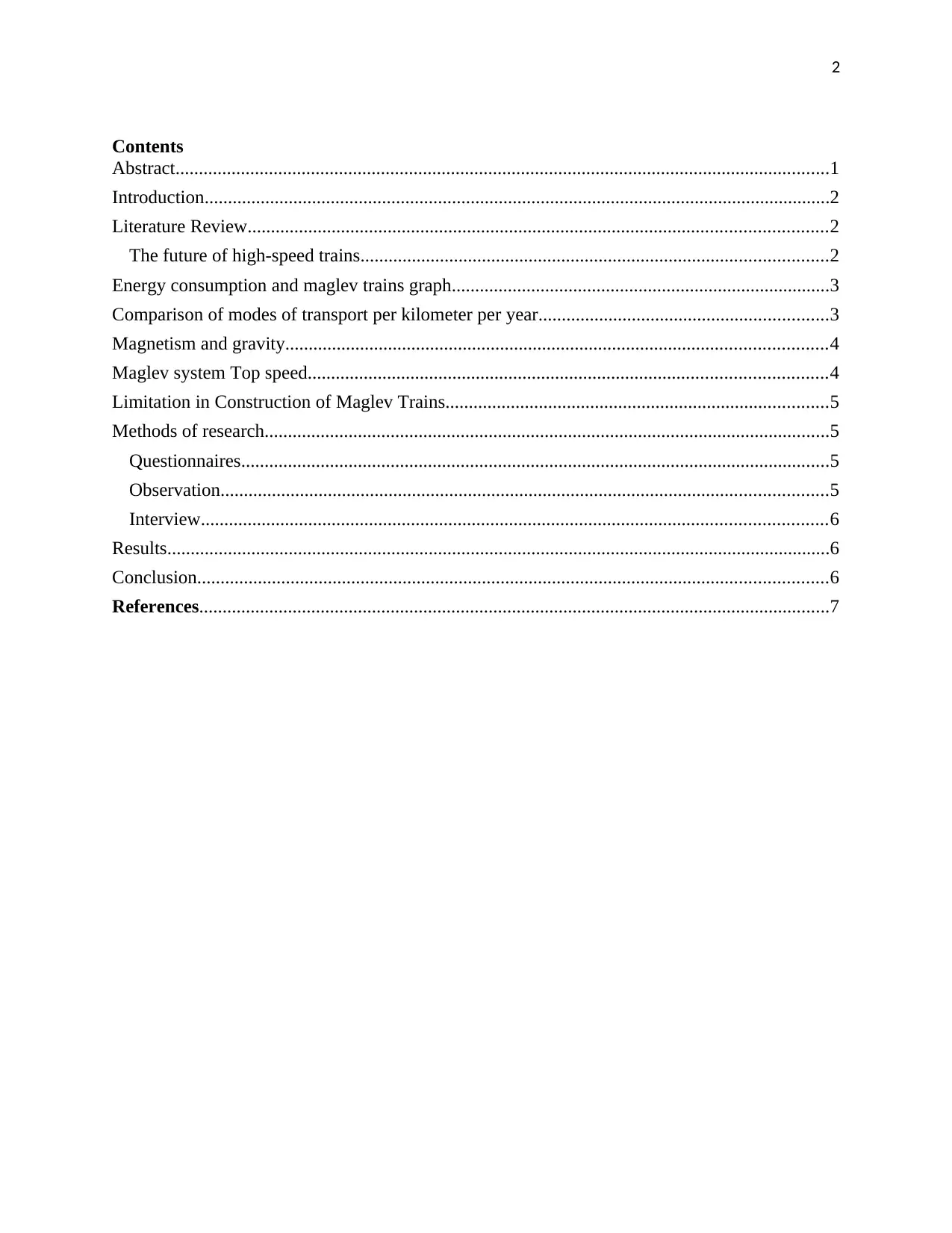
2
Contents
Abstract............................................................................................................................................1
Introduction......................................................................................................................................2
Literature Review............................................................................................................................2
The future of high-speed trains....................................................................................................2
Energy consumption and maglev trains graph.................................................................................3
Comparison of modes of transport per kilometer per year..............................................................3
Magnetism and gravity....................................................................................................................4
Maglev system Top speed...............................................................................................................4
Limitation in Construction of Maglev Trains..................................................................................5
Methods of research.........................................................................................................................5
Questionnaires..............................................................................................................................5
Observation..................................................................................................................................5
Interview......................................................................................................................................6
Results..............................................................................................................................................6
Conclusion.......................................................................................................................................6
References.......................................................................................................................................7
Contents
Abstract............................................................................................................................................1
Introduction......................................................................................................................................2
Literature Review............................................................................................................................2
The future of high-speed trains....................................................................................................2
Energy consumption and maglev trains graph.................................................................................3
Comparison of modes of transport per kilometer per year..............................................................3
Magnetism and gravity....................................................................................................................4
Maglev system Top speed...............................................................................................................4
Limitation in Construction of Maglev Trains..................................................................................5
Methods of research.........................................................................................................................5
Questionnaires..............................................................................................................................5
Observation..................................................................................................................................5
Interview......................................................................................................................................6
Results..............................................................................................................................................6
Conclusion.......................................................................................................................................6
References.......................................................................................................................................7
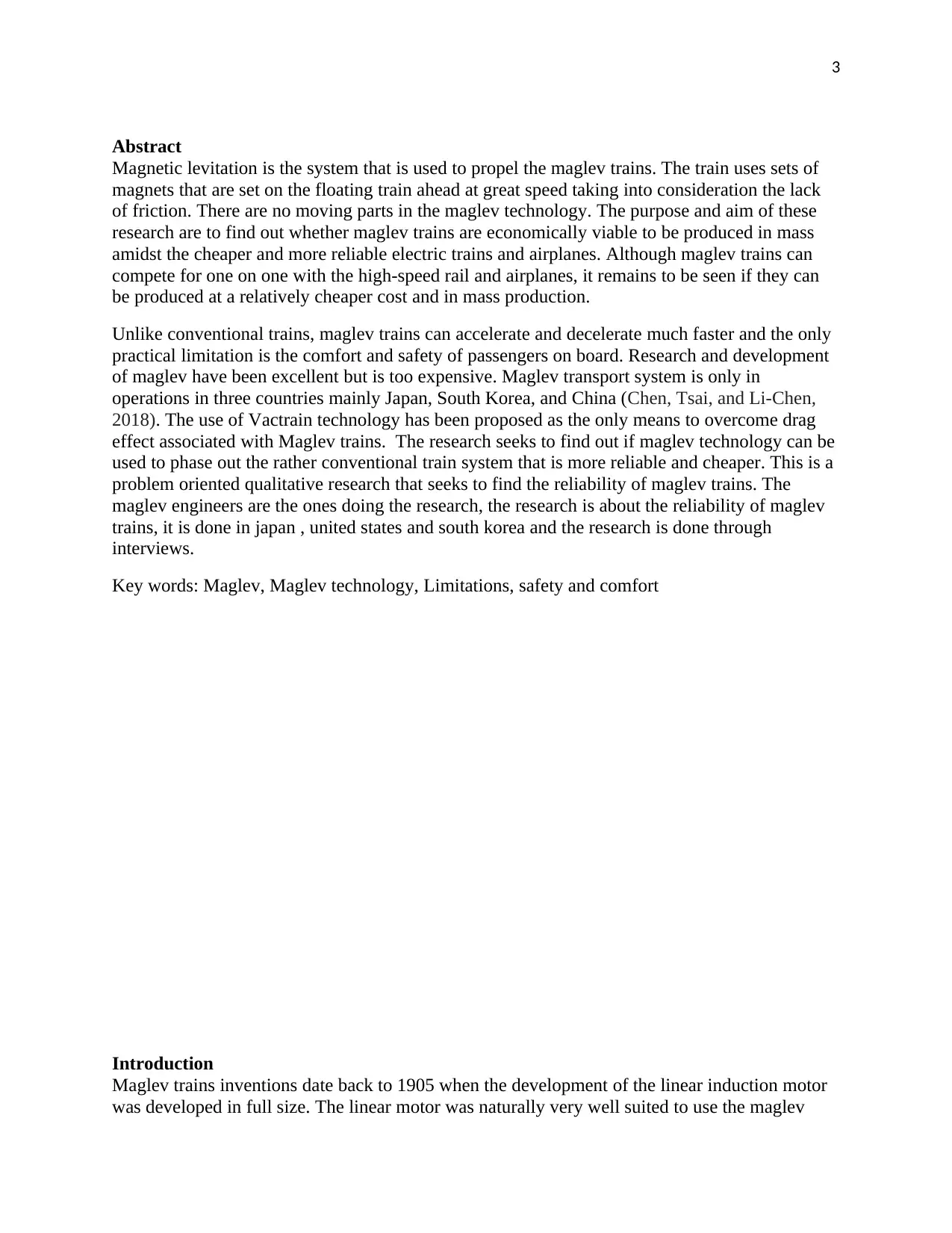
3
Abstract
Magnetic levitation is the system that is used to propel the maglev trains. The train uses sets of
magnets that are set on the floating train ahead at great speed taking into consideration the lack
of friction. There are no moving parts in the maglev technology. The purpose and aim of these
research are to find out whether maglev trains are economically viable to be produced in mass
amidst the cheaper and more reliable electric trains and airplanes. Although maglev trains can
compete for one on one with the high-speed rail and airplanes, it remains to be seen if they can
be produced at a relatively cheaper cost and in mass production.
Unlike conventional trains, maglev trains can accelerate and decelerate much faster and the only
practical limitation is the comfort and safety of passengers on board. Research and development
of maglev have been excellent but is too expensive. Maglev transport system is only in
operations in three countries mainly Japan, South Korea, and China (Chen, Tsai, and Li-Chen,
2018). The use of Vactrain technology has been proposed as the only means to overcome drag
effect associated with Maglev trains. The research seeks to find out if maglev technology can be
used to phase out the rather conventional train system that is more reliable and cheaper. This is a
problem oriented qualitative research that seeks to find the reliability of maglev trains. The
maglev engineers are the ones doing the research, the research is about the reliability of maglev
trains, it is done in japan , united states and south korea and the research is done through
interviews.
Key words: Maglev, Maglev technology, Limitations, safety and comfort
Introduction
Maglev trains inventions date back to 1905 when the development of the linear induction motor
was developed in full size. The linear motor was naturally very well suited to use the maglev
Abstract
Magnetic levitation is the system that is used to propel the maglev trains. The train uses sets of
magnets that are set on the floating train ahead at great speed taking into consideration the lack
of friction. There are no moving parts in the maglev technology. The purpose and aim of these
research are to find out whether maglev trains are economically viable to be produced in mass
amidst the cheaper and more reliable electric trains and airplanes. Although maglev trains can
compete for one on one with the high-speed rail and airplanes, it remains to be seen if they can
be produced at a relatively cheaper cost and in mass production.
Unlike conventional trains, maglev trains can accelerate and decelerate much faster and the only
practical limitation is the comfort and safety of passengers on board. Research and development
of maglev have been excellent but is too expensive. Maglev transport system is only in
operations in three countries mainly Japan, South Korea, and China (Chen, Tsai, and Li-Chen,
2018). The use of Vactrain technology has been proposed as the only means to overcome drag
effect associated with Maglev trains. The research seeks to find out if maglev technology can be
used to phase out the rather conventional train system that is more reliable and cheaper. This is a
problem oriented qualitative research that seeks to find the reliability of maglev trains. The
maglev engineers are the ones doing the research, the research is about the reliability of maglev
trains, it is done in japan , united states and south korea and the research is done through
interviews.
Key words: Maglev, Maglev technology, Limitations, safety and comfort
Introduction
Maglev trains inventions date back to 1905 when the development of the linear induction motor
was developed in full size. The linear motor was naturally very well suited to use the maglev
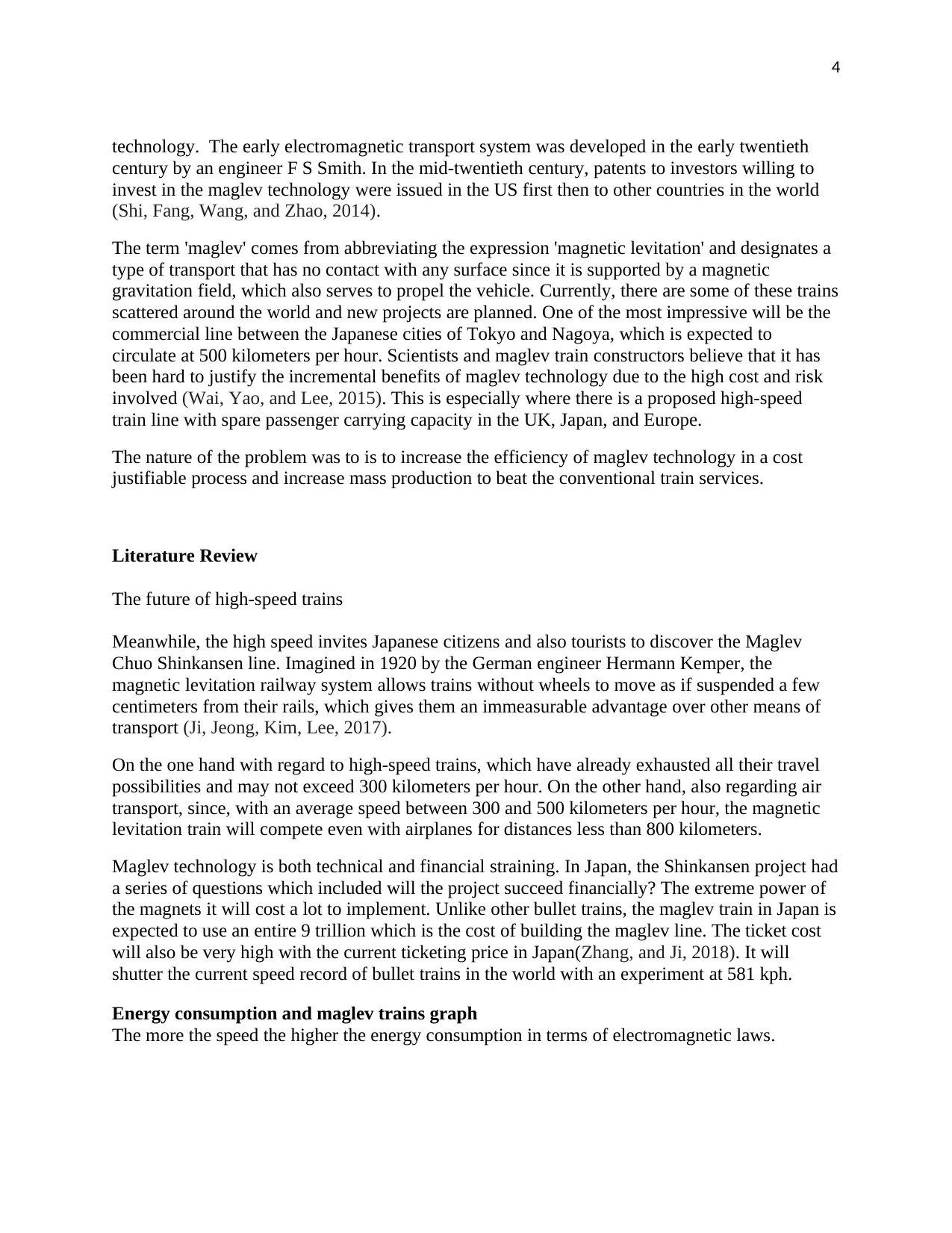
4
technology. The early electromagnetic transport system was developed in the early twentieth
century by an engineer F S Smith. In the mid-twentieth century, patents to investors willing to
invest in the maglev technology were issued in the US first then to other countries in the world
(Shi, Fang, Wang, and Zhao, 2014).
The term 'maglev' comes from abbreviating the expression 'magnetic levitation' and designates a
type of transport that has no contact with any surface since it is supported by a magnetic
gravitation field, which also serves to propel the vehicle. Currently, there are some of these trains
scattered around the world and new projects are planned. One of the most impressive will be the
commercial line between the Japanese cities of Tokyo and Nagoya, which is expected to
circulate at 500 kilometers per hour. Scientists and maglev train constructors believe that it has
been hard to justify the incremental benefits of maglev technology due to the high cost and risk
involved (Wai, Yao, and Lee, 2015). This is especially where there is a proposed high-speed
train line with spare passenger carrying capacity in the UK, Japan, and Europe.
The nature of the problem was to is to increase the efficiency of maglev technology in a cost
justifiable process and increase mass production to beat the conventional train services.
Literature Review
The future of high-speed trains
Meanwhile, the high speed invites Japanese citizens and also tourists to discover the Maglev
Chuo Shinkansen line. Imagined in 1920 by the German engineer Hermann Kemper, the
magnetic levitation railway system allows trains without wheels to move as if suspended a few
centimeters from their rails, which gives them an immeasurable advantage over other means of
transport (Ji, Jeong, Kim, Lee, 2017).
On the one hand with regard to high-speed trains, which have already exhausted all their travel
possibilities and may not exceed 300 kilometers per hour. On the other hand, also regarding air
transport, since, with an average speed between 300 and 500 kilometers per hour, the magnetic
levitation train will compete even with airplanes for distances less than 800 kilometers.
Maglev technology is both technical and financial straining. In Japan, the Shinkansen project had
a series of questions which included will the project succeed financially? The extreme power of
the magnets it will cost a lot to implement. Unlike other bullet trains, the maglev train in Japan is
expected to use an entire 9 trillion which is the cost of building the maglev line. The ticket cost
will also be very high with the current ticketing price in Japan(Zhang, and Ji, 2018). It will
shutter the current speed record of bullet trains in the world with an experiment at 581 kph.
Energy consumption and maglev trains graph
The more the speed the higher the energy consumption in terms of electromagnetic laws.
technology. The early electromagnetic transport system was developed in the early twentieth
century by an engineer F S Smith. In the mid-twentieth century, patents to investors willing to
invest in the maglev technology were issued in the US first then to other countries in the world
(Shi, Fang, Wang, and Zhao, 2014).
The term 'maglev' comes from abbreviating the expression 'magnetic levitation' and designates a
type of transport that has no contact with any surface since it is supported by a magnetic
gravitation field, which also serves to propel the vehicle. Currently, there are some of these trains
scattered around the world and new projects are planned. One of the most impressive will be the
commercial line between the Japanese cities of Tokyo and Nagoya, which is expected to
circulate at 500 kilometers per hour. Scientists and maglev train constructors believe that it has
been hard to justify the incremental benefits of maglev technology due to the high cost and risk
involved (Wai, Yao, and Lee, 2015). This is especially where there is a proposed high-speed
train line with spare passenger carrying capacity in the UK, Japan, and Europe.
The nature of the problem was to is to increase the efficiency of maglev technology in a cost
justifiable process and increase mass production to beat the conventional train services.
Literature Review
The future of high-speed trains
Meanwhile, the high speed invites Japanese citizens and also tourists to discover the Maglev
Chuo Shinkansen line. Imagined in 1920 by the German engineer Hermann Kemper, the
magnetic levitation railway system allows trains without wheels to move as if suspended a few
centimeters from their rails, which gives them an immeasurable advantage over other means of
transport (Ji, Jeong, Kim, Lee, 2017).
On the one hand with regard to high-speed trains, which have already exhausted all their travel
possibilities and may not exceed 300 kilometers per hour. On the other hand, also regarding air
transport, since, with an average speed between 300 and 500 kilometers per hour, the magnetic
levitation train will compete even with airplanes for distances less than 800 kilometers.
Maglev technology is both technical and financial straining. In Japan, the Shinkansen project had
a series of questions which included will the project succeed financially? The extreme power of
the magnets it will cost a lot to implement. Unlike other bullet trains, the maglev train in Japan is
expected to use an entire 9 trillion which is the cost of building the maglev line. The ticket cost
will also be very high with the current ticketing price in Japan(Zhang, and Ji, 2018). It will
shutter the current speed record of bullet trains in the world with an experiment at 581 kph.
Energy consumption and maglev trains graph
The more the speed the higher the energy consumption in terms of electromagnetic laws.
Paraphrase This Document
Need a fresh take? Get an instant paraphrase of this document with our AI Paraphraser
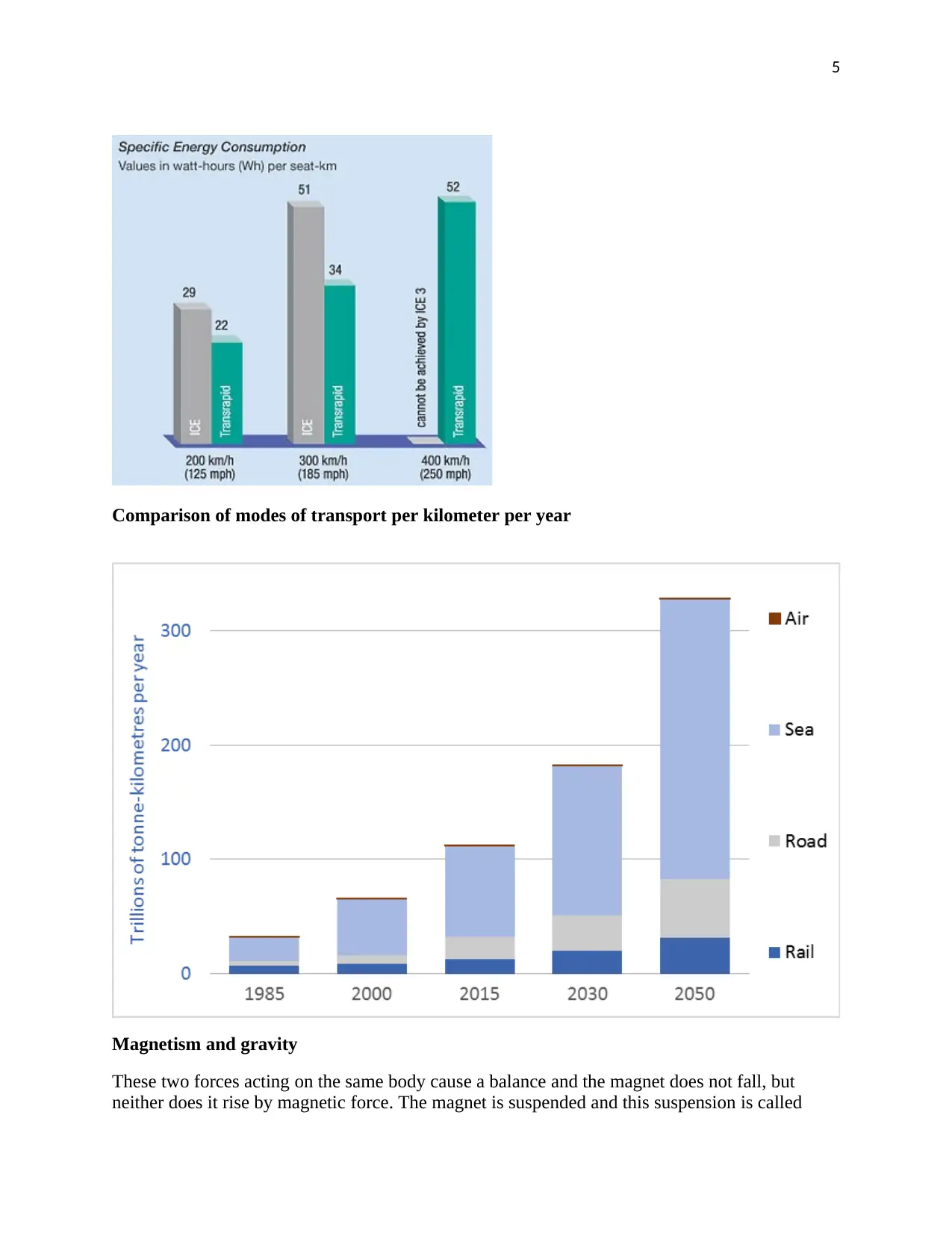
5
Comparison of modes of transport per kilometer per year
Magnetism and gravity
These two forces acting on the same body cause a balance and the magnet does not fall, but
neither does it rise by magnetic force. The magnet is suspended and this suspension is called
Comparison of modes of transport per kilometer per year
Magnetism and gravity
These two forces acting on the same body cause a balance and the magnet does not fall, but
neither does it rise by magnetic force. The magnet is suspended and this suspension is called
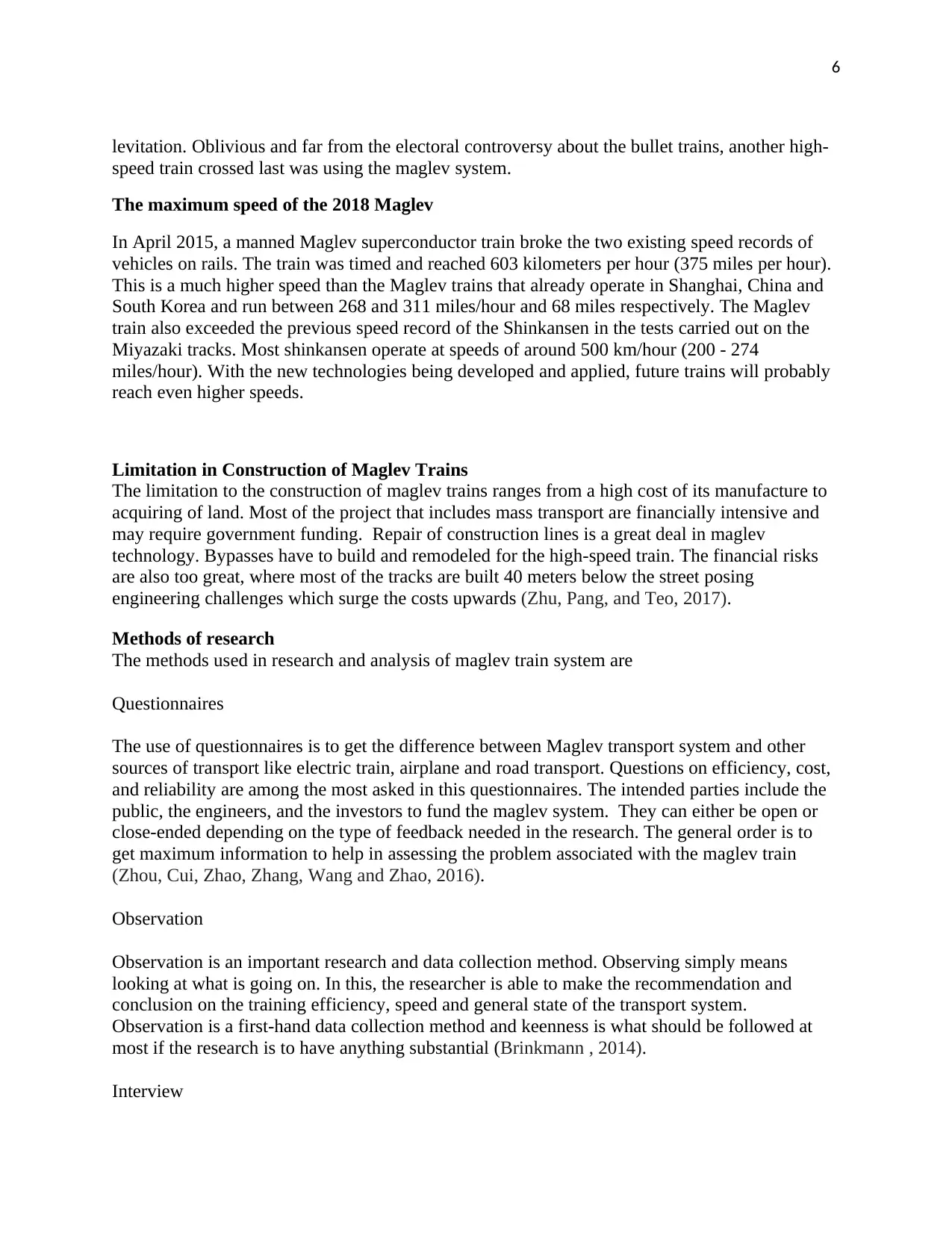
6
levitation. Oblivious and far from the electoral controversy about the bullet trains, another high-
speed train crossed last was using the maglev system.
The maximum speed of the 2018 Maglev
In April 2015, a manned Maglev superconductor train broke the two existing speed records of
vehicles on rails. The train was timed and reached 603 kilometers per hour (375 miles per hour).
This is a much higher speed than the Maglev trains that already operate in Shanghai, China and
South Korea and run between 268 and 311 miles/hour and 68 miles respectively. The Maglev
train also exceeded the previous speed record of the Shinkansen in the tests carried out on the
Miyazaki tracks. Most shinkansen operate at speeds of around 500 km/hour (200 - 274
miles/hour). With the new technologies being developed and applied, future trains will probably
reach even higher speeds.
Limitation in Construction of Maglev Trains
The limitation to the construction of maglev trains ranges from a high cost of its manufacture to
acquiring of land. Most of the project that includes mass transport are financially intensive and
may require government funding. Repair of construction lines is a great deal in maglev
technology. Bypasses have to build and remodeled for the high-speed train. The financial risks
are also too great, where most of the tracks are built 40 meters below the street posing
engineering challenges which surge the costs upwards (Zhu, Pang, and Teo, 2017).
Methods of research
The methods used in research and analysis of maglev train system are
Questionnaires
The use of questionnaires is to get the difference between Maglev transport system and other
sources of transport like electric train, airplane and road transport. Questions on efficiency, cost,
and reliability are among the most asked in this questionnaires. The intended parties include the
public, the engineers, and the investors to fund the maglev system. They can either be open or
close-ended depending on the type of feedback needed in the research. The general order is to
get maximum information to help in assessing the problem associated with the maglev train
(Zhou, Cui, Zhao, Zhang, Wang and Zhao, 2016).
Observation
Observation is an important research and data collection method. Observing simply means
looking at what is going on. In this, the researcher is able to make the recommendation and
conclusion on the training efficiency, speed and general state of the transport system.
Observation is a first-hand data collection method and keenness is what should be followed at
most if the research is to have anything substantial (Brinkmann , 2014).
Interview
levitation. Oblivious and far from the electoral controversy about the bullet trains, another high-
speed train crossed last was using the maglev system.
The maximum speed of the 2018 Maglev
In April 2015, a manned Maglev superconductor train broke the two existing speed records of
vehicles on rails. The train was timed and reached 603 kilometers per hour (375 miles per hour).
This is a much higher speed than the Maglev trains that already operate in Shanghai, China and
South Korea and run between 268 and 311 miles/hour and 68 miles respectively. The Maglev
train also exceeded the previous speed record of the Shinkansen in the tests carried out on the
Miyazaki tracks. Most shinkansen operate at speeds of around 500 km/hour (200 - 274
miles/hour). With the new technologies being developed and applied, future trains will probably
reach even higher speeds.
Limitation in Construction of Maglev Trains
The limitation to the construction of maglev trains ranges from a high cost of its manufacture to
acquiring of land. Most of the project that includes mass transport are financially intensive and
may require government funding. Repair of construction lines is a great deal in maglev
technology. Bypasses have to build and remodeled for the high-speed train. The financial risks
are also too great, where most of the tracks are built 40 meters below the street posing
engineering challenges which surge the costs upwards (Zhu, Pang, and Teo, 2017).
Methods of research
The methods used in research and analysis of maglev train system are
Questionnaires
The use of questionnaires is to get the difference between Maglev transport system and other
sources of transport like electric train, airplane and road transport. Questions on efficiency, cost,
and reliability are among the most asked in this questionnaires. The intended parties include the
public, the engineers, and the investors to fund the maglev system. They can either be open or
close-ended depending on the type of feedback needed in the research. The general order is to
get maximum information to help in assessing the problem associated with the maglev train
(Zhou, Cui, Zhao, Zhang, Wang and Zhao, 2016).
Observation
Observation is an important research and data collection method. Observing simply means
looking at what is going on. In this, the researcher is able to make the recommendation and
conclusion on the training efficiency, speed and general state of the transport system.
Observation is a first-hand data collection method and keenness is what should be followed at
most if the research is to have anything substantial (Brinkmann , 2014).
Interview
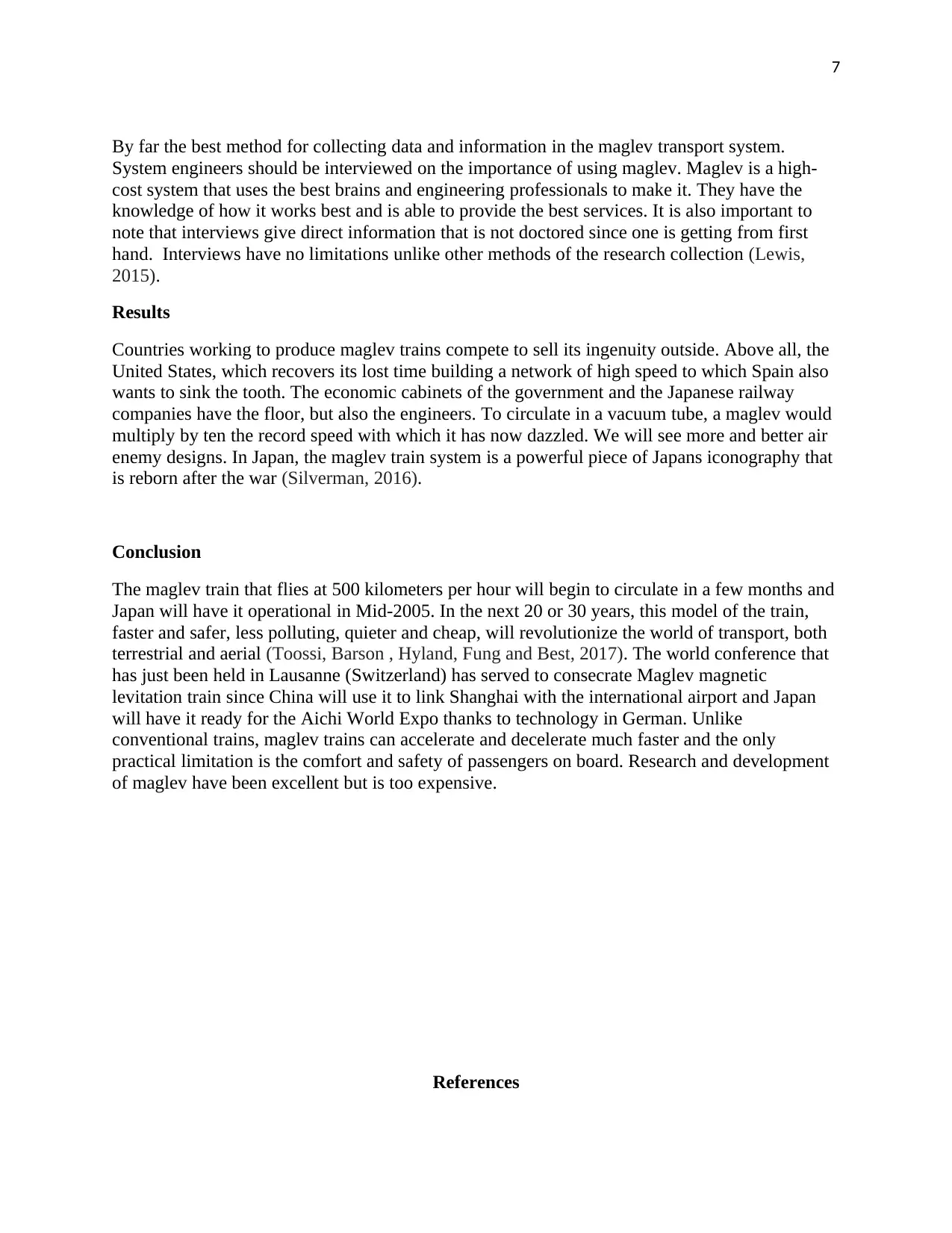
7
By far the best method for collecting data and information in the maglev transport system.
System engineers should be interviewed on the importance of using maglev. Maglev is a high-
cost system that uses the best brains and engineering professionals to make it. They have the
knowledge of how it works best and is able to provide the best services. It is also important to
note that interviews give direct information that is not doctored since one is getting from first
hand. Interviews have no limitations unlike other methods of the research collection (Lewis,
2015).
Results
Countries working to produce maglev trains compete to sell its ingenuity outside. Above all, the
United States, which recovers its lost time building a network of high speed to which Spain also
wants to sink the tooth. The economic cabinets of the government and the Japanese railway
companies have the floor, but also the engineers. To circulate in a vacuum tube, a maglev would
multiply by ten the record speed with which it has now dazzled. We will see more and better air
enemy designs. In Japan, the maglev train system is a powerful piece of Japans iconography that
is reborn after the war (Silverman, 2016).
Conclusion
The maglev train that flies at 500 kilometers per hour will begin to circulate in a few months and
Japan will have it operational in Mid-2005. In the next 20 or 30 years, this model of the train,
faster and safer, less polluting, quieter and cheap, will revolutionize the world of transport, both
terrestrial and aerial (Toossi, Barson , Hyland, Fung and Best, 2017). The world conference that
has just been held in Lausanne (Switzerland) has served to consecrate Maglev magnetic
levitation train since China will use it to link Shanghai with the international airport and Japan
will have it ready for the Aichi World Expo thanks to technology in German. Unlike
conventional trains, maglev trains can accelerate and decelerate much faster and the only
practical limitation is the comfort and safety of passengers on board. Research and development
of maglev have been excellent but is too expensive.
References
By far the best method for collecting data and information in the maglev transport system.
System engineers should be interviewed on the importance of using maglev. Maglev is a high-
cost system that uses the best brains and engineering professionals to make it. They have the
knowledge of how it works best and is able to provide the best services. It is also important to
note that interviews give direct information that is not doctored since one is getting from first
hand. Interviews have no limitations unlike other methods of the research collection (Lewis,
2015).
Results
Countries working to produce maglev trains compete to sell its ingenuity outside. Above all, the
United States, which recovers its lost time building a network of high speed to which Spain also
wants to sink the tooth. The economic cabinets of the government and the Japanese railway
companies have the floor, but also the engineers. To circulate in a vacuum tube, a maglev would
multiply by ten the record speed with which it has now dazzled. We will see more and better air
enemy designs. In Japan, the maglev train system is a powerful piece of Japans iconography that
is reborn after the war (Silverman, 2016).
Conclusion
The maglev train that flies at 500 kilometers per hour will begin to circulate in a few months and
Japan will have it operational in Mid-2005. In the next 20 or 30 years, this model of the train,
faster and safer, less polluting, quieter and cheap, will revolutionize the world of transport, both
terrestrial and aerial (Toossi, Barson , Hyland, Fung and Best, 2017). The world conference that
has just been held in Lausanne (Switzerland) has served to consecrate Maglev magnetic
levitation train since China will use it to link Shanghai with the international airport and Japan
will have it ready for the Aichi World Expo thanks to technology in German. Unlike
conventional trains, maglev trains can accelerate and decelerate much faster and the only
practical limitation is the comfort and safety of passengers on board. Research and development
of maglev have been excellent but is too expensive.
References
Secure Best Marks with AI Grader
Need help grading? Try our AI Grader for instant feedback on your assignments.
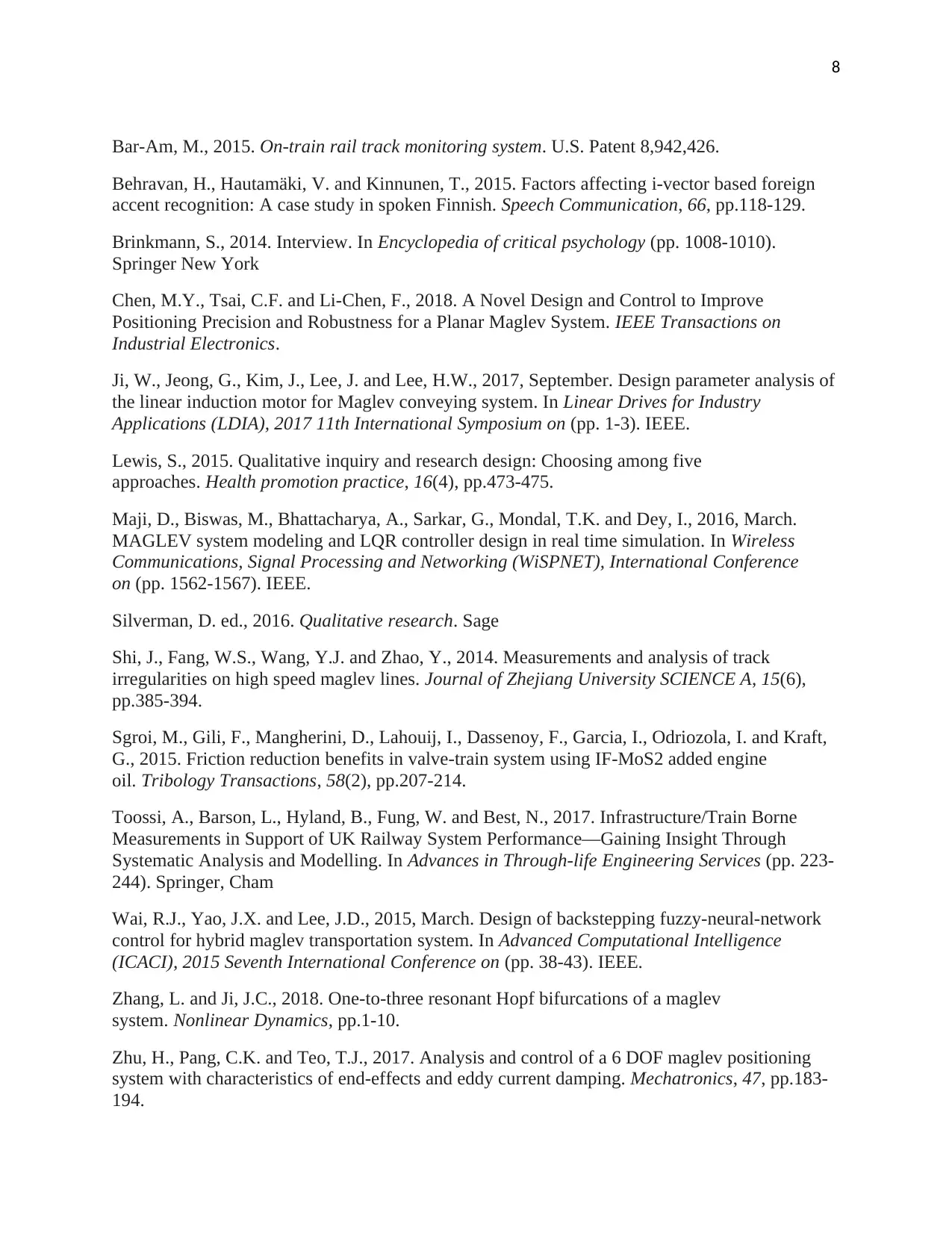
8
Bar-Am, M., 2015. On-train rail track monitoring system. U.S. Patent 8,942,426.
Behravan, H., Hautamäki, V. and Kinnunen, T., 2015. Factors affecting i-vector based foreign
accent recognition: A case study in spoken Finnish. Speech Communication, 66, pp.118-129.
Brinkmann, S., 2014. Interview. In Encyclopedia of critical psychology (pp. 1008-1010).
Springer New York
Chen, M.Y., Tsai, C.F. and Li-Chen, F., 2018. A Novel Design and Control to Improve
Positioning Precision and Robustness for a Planar Maglev System. IEEE Transactions on
Industrial Electronics.
Ji, W., Jeong, G., Kim, J., Lee, J. and Lee, H.W., 2017, September. Design parameter analysis of
the linear induction motor for Maglev conveying system. In Linear Drives for Industry
Applications (LDIA), 2017 11th International Symposium on (pp. 1-3). IEEE.
Lewis, S., 2015. Qualitative inquiry and research design: Choosing among five
approaches. Health promotion practice, 16(4), pp.473-475.
Maji, D., Biswas, M., Bhattacharya, A., Sarkar, G., Mondal, T.K. and Dey, I., 2016, March.
MAGLEV system modeling and LQR controller design in real time simulation. In Wireless
Communications, Signal Processing and Networking (WiSPNET), International Conference
on (pp. 1562-1567). IEEE.
Silverman, D. ed., 2016. Qualitative research. Sage
Shi, J., Fang, W.S., Wang, Y.J. and Zhao, Y., 2014. Measurements and analysis of track
irregularities on high speed maglev lines. Journal of Zhejiang University SCIENCE A, 15(6),
pp.385-394.
Sgroi, M., Gili, F., Mangherini, D., Lahouij, I., Dassenoy, F., Garcia, I., Odriozola, I. and Kraft,
G., 2015. Friction reduction benefits in valve-train system using IF-MoS2 added engine
oil. Tribology Transactions, 58(2), pp.207-214.
Toossi, A., Barson, L., Hyland, B., Fung, W. and Best, N., 2017. Infrastructure/Train Borne
Measurements in Support of UK Railway System Performance—Gaining Insight Through
Systematic Analysis and Modelling. In Advances in Through-life Engineering Services (pp. 223-
244). Springer, Cham
Wai, R.J., Yao, J.X. and Lee, J.D., 2015, March. Design of backstepping fuzzy-neural-network
control for hybrid maglev transportation system. In Advanced Computational Intelligence
(ICACI), 2015 Seventh International Conference on (pp. 38-43). IEEE.
Zhang, L. and Ji, J.C., 2018. One-to-three resonant Hopf bifurcations of a maglev
system. Nonlinear Dynamics, pp.1-10.
Zhu, H., Pang, C.K. and Teo, T.J., 2017. Analysis and control of a 6 DOF maglev positioning
system with characteristics of end-effects and eddy current damping. Mechatronics, 47, pp.183-
194.
Bar-Am, M., 2015. On-train rail track monitoring system. U.S. Patent 8,942,426.
Behravan, H., Hautamäki, V. and Kinnunen, T., 2015. Factors affecting i-vector based foreign
accent recognition: A case study in spoken Finnish. Speech Communication, 66, pp.118-129.
Brinkmann, S., 2014. Interview. In Encyclopedia of critical psychology (pp. 1008-1010).
Springer New York
Chen, M.Y., Tsai, C.F. and Li-Chen, F., 2018. A Novel Design and Control to Improve
Positioning Precision and Robustness for a Planar Maglev System. IEEE Transactions on
Industrial Electronics.
Ji, W., Jeong, G., Kim, J., Lee, J. and Lee, H.W., 2017, September. Design parameter analysis of
the linear induction motor for Maglev conveying system. In Linear Drives for Industry
Applications (LDIA), 2017 11th International Symposium on (pp. 1-3). IEEE.
Lewis, S., 2015. Qualitative inquiry and research design: Choosing among five
approaches. Health promotion practice, 16(4), pp.473-475.
Maji, D., Biswas, M., Bhattacharya, A., Sarkar, G., Mondal, T.K. and Dey, I., 2016, March.
MAGLEV system modeling and LQR controller design in real time simulation. In Wireless
Communications, Signal Processing and Networking (WiSPNET), International Conference
on (pp. 1562-1567). IEEE.
Silverman, D. ed., 2016. Qualitative research. Sage
Shi, J., Fang, W.S., Wang, Y.J. and Zhao, Y., 2014. Measurements and analysis of track
irregularities on high speed maglev lines. Journal of Zhejiang University SCIENCE A, 15(6),
pp.385-394.
Sgroi, M., Gili, F., Mangherini, D., Lahouij, I., Dassenoy, F., Garcia, I., Odriozola, I. and Kraft,
G., 2015. Friction reduction benefits in valve-train system using IF-MoS2 added engine
oil. Tribology Transactions, 58(2), pp.207-214.
Toossi, A., Barson, L., Hyland, B., Fung, W. and Best, N., 2017. Infrastructure/Train Borne
Measurements in Support of UK Railway System Performance—Gaining Insight Through
Systematic Analysis and Modelling. In Advances in Through-life Engineering Services (pp. 223-
244). Springer, Cham
Wai, R.J., Yao, J.X. and Lee, J.D., 2015, March. Design of backstepping fuzzy-neural-network
control for hybrid maglev transportation system. In Advanced Computational Intelligence
(ICACI), 2015 Seventh International Conference on (pp. 38-43). IEEE.
Zhang, L. and Ji, J.C., 2018. One-to-three resonant Hopf bifurcations of a maglev
system. Nonlinear Dynamics, pp.1-10.
Zhu, H., Pang, C.K. and Teo, T.J., 2017. Analysis and control of a 6 DOF maglev positioning
system with characteristics of end-effects and eddy current damping. Mechatronics, 47, pp.183-
194.

9
Zhou, D., Cui, C., Zhao, L., Zhang, Y., Wang, X. and Zhao, Y., 2016. Static and dynamic
stability of the guidance force in a side-suspended HTS maglev system. Superconductor Science
and Technology, 30(2), p.025019.
.
.
Zhou, D., Cui, C., Zhao, L., Zhang, Y., Wang, X. and Zhao, Y., 2016. Static and dynamic
stability of the guidance force in a side-suspended HTS maglev system. Superconductor Science
and Technology, 30(2), p.025019.
.
.
1 out of 9
![[object Object]](/_next/static/media/star-bottom.7253800d.svg)